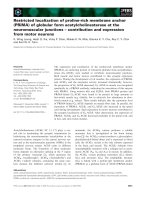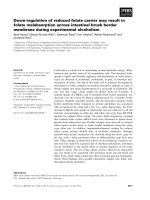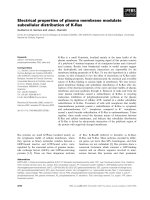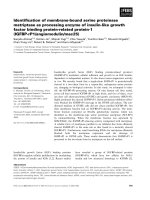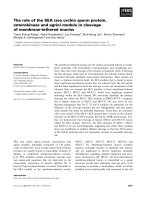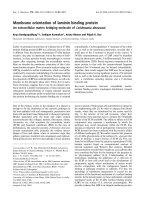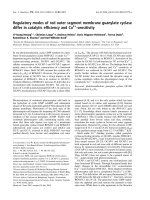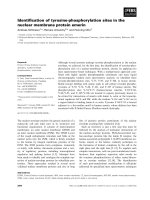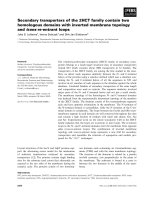Báo cáo khoa học: Membrane anchoring of diacylglycerol lactones substituted with rigid hydrophobic acyl domains correlates with biological activities ppt
Bạn đang xem bản rút gọn của tài liệu. Xem và tải ngay bản đầy đủ của tài liệu tại đây (753.98 KB, 11 trang )
Membrane anchoring of diacylglycerol lactones
substituted with rigid hydrophobic acyl domains
correlates with biological activities
Or Raifman
1
, Sofiya Kolusheva
1
, Maria J. Comin
2
, Noemi Kedei
3
, Nancy E. Lewin
3
,
Peter M. Blumberg
3
, Victor E. Marquez
2
and Raz Jelinek
1
1 Department of Chemistry, Ben Gurion University, Beer Sheva, Israel
2 Laboratory of Medicinal Chemistry, Center for Cancer Research, National Cancer Institute at Frederick, National Institutes of Health,
Frederick, MD, USA
3 Laboratory of Cancer Biology and Genetics, Center for Cancer Research, National Cancer Institute, Bethesda, MD, USA
Introduction
The lipophilic second messenger sn-1,2-diacylglycerol
(DAG) is released in situ from membrane phosphati-
dylinositol 4,5-bisphosphate through the action of
phospholipase C in response to induction of a wide
range of G-protein-coupled receptors and receptor
tyrosine kinases [1]. As a second messenger, DAG
Keywords
biomimetic membranes; diacylglycerol;
diacylglycerol lactones (DAG-lactones);
membrane interactions; PKC translocation
Correspondence
V. E. Marquez, Laboratory of Medicinal
Chemistry, Center for Cancer Research,
National Cancer Institute at Frederick,
National Institutes of Health, 376 Boyles
Street, Frederick, MD 21702, USA
Fax: +1 3018466033
Tel: +1 3018465954
E-mail:
R. Jelinek, Department of Chemistry, Ben
Gurion University, Beer Sheva 84105, Israel
Fax: +972 86472943
Tel: +972 86461747
E-mail:
(Received 27 August 2009, revised 15
October 2009, accepted 4 November
2009)
doi:10.1111/j.1742-4658.2009.07477.x
Synthetic diacylglycerol lactones (DAG lactones) are effective modulators
of critical cellular signaling pathways downstream of the lipophilic second
messenger diacylglycerol that activate a host of protein kinase C (PKC)
isozymes as well as other non-kinase proteins that share with PKC similar
C1 membrane-targeting domains. A fundamental determinant of the bio-
logical activity of these amphiphilic molecules is the nature of their interac-
tions with cellular membranes. This study characterizes the membrane
interactions and bilayer anchoring of a series of DAG lactones in which
the hydrophobic moiety is a ‘molecular rod’, namely a rigid 4-[2-
(R-phenyl)ethynyl]benzoate moiety in the acyl position. Use of assays
employing chromatic biomimetic vesicles and biophysical techniques
revealed that the mode of membrane anchoring of the DAG lactone deriv-
atives was markedly affected by the presence of the hydrophobic diphenyl
rod and by the size of the functional unit at the terminus of the rod. Two
primary mechanisms of interaction were observed: surface binding of the
DAG lactones at the lipid ⁄ water interface and deep insertion of the ligands
into the alkyl core of the lipid bilayer. These membrane-insertion properties
could explain the different patterns of the PKC translocation from the
cytosol to membranes that is induced by the molecular-rod DAG lactones.
This investigation emphasizes that the side residues of DAG lactones,
rather than simply conferring hydrophobicity, profoundly influence
membrane interactions, and thus may further contribute to the diversity of
biological actions of these synthetic biomimetic ligands.
Abbreviations
cryo-TEM, cryogenic transmission electron microscopy; DAG, diacylglycerol; DMPC, dimyristoylphosphatidylcholine; DSC, differential
scanning calorimetry; %FCR, percentage fluorescence chromatic response; NBD-PE, N-(7-nitrobenz-2-oxa-1,3-diazol-4-yl)1,2-dihexadecanoyl-
sn-glycero-3-phosphoethanolamine triethylammonium salt; PDA, polydiacetylene; PKC, protein kinase C; TMA-DPH,
1-(4-trimethylammoniumphenyl)-6-phenyl-1,3,5-hexatriene.
FEBS Journal 277 (2010) 233–243 ª 2009 The Authors Journal compilation ª 2009 FEBS 233
mediates the action of numerous growth factors, hor-
mones and cytokines by activating members of the
protein kinase C (PKC) family of enzymes, as well as
several other families of signaling proteins, e.g. Ras
guanyl nucleotide-releasing protein (RasGRPs) and
chimaerins, that share with PKC the C1 domain as a
DAG recognition motif. Many of these signaling path-
ways feature prominently in the development and
properties of cancer cells [2,3], and, in consequence,
PKC isozymes are being actively studied as possible
therapeutic targets for cancer [4]. The majority of C1
binding ligands that are utilized are structurally rigid
and complex natural products, such as the prototypical
phorbol esters and bryostatins [5] These compounds
bind their C1 receptors with nanomolar binding affini-
ties, and are more than three orders of magnitude
more effective than the very flexible natural DAG ag-
onists. In order to overcome this affinity gap and gen-
erate structures that are simpler and easy to synthesize,
we have proposed overcoming the entropic penalty
associated with the flexible glycerol backbone by con-
structing cyclic esters of DAG with the embedded glyc-
erol backbone in various rigid conformations. In a
comprehensive review, we discussed the reasons for
selecting the five-member ring lactones, which are
generically described as DAG lactones [6]. Many of
these DAG lactones possess affinities for PKC that
approach those of the phorbol esters, and show
marked diversity in the patterns of biological response
that they induced as a function of the chemical nature
of the side chains [6–9].
The concept that has emerged from these studies is
that different patterns of substitution on the conforma-
tionally restricted DAG lactone template allow prefer-
entially interaction with PKC isozymes within
particular membrane microenvironments, promoting
phosphorylation of substrates co-localized with the
activated PKC.
Previous results obtained with DAG lactones
containing acyl chains with an ensemble of repetitive
oligo(p-phenylene-ethynylene) units that form a rigid
rod showed that two units is the ideal length of the
rod [10]. The synthesis of several DAG lactones ful-
filling this structural constraint has already yielded
important insights into the mechanisms of self-assem-
bly and lipid interactions at the water ⁄ air interface,
and the diverse effects of various lipids upon the
organization and thermodynamic properties of the
molecules [11]. Because the end residue of the rod
(R) was shown to interact with the inner layer of
the membrane and to modulate its surrounding envi-
ronment, we focused in the present study on a group
of compounds in which the R terminus of the rigid
rod was varied from the smallest possible, i.e. a
hydrogen atom, to the bulkier isopropyl (i-Pr) and
tertbutyl (t-Bu) groups (Table 1). As before, we com-
pared these compounds to a DAG lactone with a
flexible decanoic acid chain (compound 1, Table 1).
The experiments were designed to explore both the
roles of the rod side residue, as well as the proper-
ties of the larger alkyl R units in modulating bilayer
interactions.
Here, we investigate the interactions and association
of DAG lactones 1–4 with lipid vesicles, and correlate
the data with their binding affinities for PKCa and
their ability to induce translocation of PKC to cellular
membranes. These ligands are shown to induce differ-
ent patterns and kinetics for translocation of PKC
isoforms to membranes, and this study aims to exam-
ine whether membrane association might account for
the biological differences. Application of several bio-
physical techniques, including use of biomimetic
chromatic vesicles [12–14], fluorescence quenching [15],
fluorescence anisotropy [16], differential scanning
Table 1. Structure and properties of the DAG lactones.
O
O
O
HO
O
1
O
O
O
HO
O
R2–4
.
Compound R log P
a
K
i
(nM)
b
1 – 3.68 9.0 ± 1.2
c
2 H 3.26
d
6.6 ± 0.6
d
3 i-Pr 4.38 5.6 ± 1.1
c
4 t -Bu 4.56 5.3 ± 0.9
c
a
The partition coefficient (octanol ⁄ water partition coefficient = log
P) is a measure of the hydrophobic ⁄ hydrophilic balance of the mol-
ecule and is calculated by the atom-based program MOE SlogP
[19].
b
The K
i
value measures the affinity of the ligand in terms of
its ability to displace bound [
3
H-20]phorbol 12,13-dibutyrate from
PKCa. The lower the K
i
, the more effective the ligand. Values rep-
resenting the mean ± SEM of three independent experiments were
determined as described previously [11].
c
Values determined in
the same set of experiments. For compound 1, we previously
obtained and reported a value of 15.9 ± 1.1 n
M [9].
d
Values from
ref. [11].
Membrane interactions of diacylglycerol derivatives O. Raifman et al.
234 FEBS Journal 277 (2010) 233–243 ª 2009 The Authors Journal compilation ª 2009 FEBS
calorimetry (DSC) [17] and cryogenic transmission
electron microscopy (cryo-TEM) [18], revealed signifi-
cantly different modes of bilayer binding of the rod
compounds depending on their structure, and high-
lighted the role of the R terminus in affecting mem-
brane insertion and biological activity of the DAG
lactones. The results shed light upon the molecular
parameters affecting PKC translocation to membranes
by DAG lactones.
Results
Membrane translocation
To analyze membrane interactions of the DAG
lactones, we first evaluated their cellular effects. Com-
pounds 2–4 showed similar high affinity for PKCa as
did DAG lactone 1 in in vitro assays in the presence
of 100 lgÆmL
)1
phosphatidylserine (Table 1). To
study the behavior of these DAG lactones in living
cells, we first determined the pattern and kinetics of
the translocation of overexpressed, GFP-tagged PKCa
and PKCd to the membranes of Chinese hamster
ovary (CHO) cells following addition of the com-
pounds (Fig. 1). As reported previously [10], DAG
lactone 1, included in this study as a DAG lactone
derivative which exhibits a highly flexible side residue,
translocated both PKCa and d almost instantaneously
to the cellular membranes, within less than 2 min
(Fig. 1A). Furthermore, lactone 1 induced PKCd
translocation simultaneously to the plasma membrane
and to the internal membranes [10]. The translocation
to the cellular membranes of both PKCa and d was
transient, unlike that caused by phorbol 12-myristate
13-acetate (the standard derivative used to character-
ize responses of PKC to phorbol esters or other
ligands targeted to the C1 domain), or by the DAG-
lactones containing rigid rod side chains described
previously [10].
Figure 1 shows that DAG-lactone 2 is more similar
to DAG-lactone 1 and DAG-lactone 3 is more similar
to DAG-lactone 4 for inducing PKC translocation to
the membranes. Specifically, DAG-lactones 1 and 2,
unlike PMA, gave rise to almost simultaneous translo-
cation of PKC-d to the plasma membrane, to the
nuclear membrane, and to other internal membranes
overall exhibiting a patchy distribution (Fig. 1A–B,
top row). In contrast, 3 and 4, similarly to PMA,
translocated PKC-d in a sequential manner, initially to
the plasma membrane and only later to the nuclear
membrane and other internal membranes (Fig. 1C and
D, top rows). Additionally, the PKC-a translocation
induced by 3 and 4 appears to be somewhat slower
than the corresponding process induced by 1 and 2
(Fig. 1A–D, bottom rows).
Chromatic vesicle analysis
To elucidate the mechanistic basis for the differences
in the translocation patterns of PKC induced by DAG
lactones 2–4 apparent in Fig. 1, we applied several bio-
physical techniques to characterize the membrane
interactions of the molecules. Figure 2 shows the con-
centration dependence of the fluorescence chromatic
response (%FCR, see Experimental procedures)
following addition of DAG lactones 1–4 to biomi-
metic dimyristoylphosphatidylcholine (DMPC) ⁄ choles-
terol ⁄ polydiacetylene (PDA) vesicles (mole ratio
1 : 1 : 3). Lipid ⁄ PDA vesicle assays have been used
previously for analysis of lipid bilayer interactions of
membrane-associated biological and pharmaceutical
molecules [13,20]. Lipid ⁄ PDA vesicles consist of lipid
bilayer domains (serving as biomimetic membrane
docking areas) interspersed with PDA patches, which
act as the chromatic reporting units [12–14]. The spe-
cific lipid composition used here, comprising DMPC
and cholesterol, was designed to approximate cell-
membrane environments [21].
The divergent chromatic dose–response curves in
Fig. 2 indicate differences in membrane association of
the DAG lactones 1-4. Specifically, DAG lactone 2
produced the most moderate increase in fluorescence
chromatic response when incubated with the vesicles,
while DAG lactone 4
, in contrast, gave rise to the
steepest %FCR dose–response curve (Fig. 2). The
chromatic response curves of DAG lactones 1 and 3
were between those of DAG lactones 2 and 4 , and
were closer to that of DAG lactone 2.
Previous studies have correlated the steepness (i.e.
slope) of the chromatic dose–response curves of
lipid ⁄ PDA vesicles with the degree of bilayer inser-
tion of the tested compounds [13,20]. Generally, mol-
ecules that penetrate deep into the hydrophobic core
of the lipid bilayer induce lower chromatic transfor-
mations of the lipid ⁄ PDA vesicles (i.e. a more mod-
erate increase for the chromatic dose–response
curves). On the other hand, substances that show
significant interactions with the lipid surface (lipid ⁄
water interface) were found to induce relatively more
pronounced chromatic response (steeper dose–
response curves) [22]. Thus, DAG lactone 2 most
likely inserts deeper into the vesicle bilayers com-
pared to the other DAG lactones examined, while
DAG lactone 4 shows more pronounced surface
interactions, inducing the steeper dose–response curve
in Fig. 2.
O. Raifman et al. Membrane interactions of diacylglycerol derivatives
FEBS Journal 277 (2010) 233–243 ª 2009 The Authors Journal compilation ª 2009 FEBS 235
A
B
C
D
0 min 2 min 10 min 30 min
0 min 2 min 10 min 30 min
0 min 2 min 10 min 30 min
0 min 2 min 5 min 30 min
0 min 10 min 20 min 30 min
0 min 2 min 10 min 30 min
0 min
PKC-α
PKC-δ
PKC-α
PKC-δ
PKC-α
PKC-δ
PKC-α
PKC-δ
10 min 20 min 30 min
0 min 5 min 10 min 30 min
Fig. 1. PKC translocation. Confocal micros-
copy images of CHO cells overexpressing
GFP–PKCd (top) and GFP–PKCa (bottom),
following treatment with (A) DAG lactone 1,
(B) DAG lactone 2, (C) DAG lactone 3, and
(D) DAG lactone 4. The final concentrations
of all compounds were 10 l
M.
Membrane interactions of diacylglycerol derivatives O. Raifman et al.
236 FEBS Journal 277 (2010) 233–243 ª 2009 The Authors Journal compilation ª 2009 FEBS
Biophysical analysis
To further probe the interactions of DAG lactones 1–4
with lipid bilayers, particularly the extent of their
localization at the vesicle interface, we performed
fluorescence quenching experiments utilizing DMPC ⁄
cholesterol vesicles into which the fluorescence probe
N-(7-nitrobenz-2-oxa-1,3-diazol-4-yl)1,2-dihexadecanoyl-
sn-glycero-3-phosphoethanolamine triethylammonium
salt (NBD-PE) was incorporated [15] (Fig. 3). The
NBD dye is embedded close to the bilayer interface,
providing a useful marker for surface interactions of
membrane-active compounds. The experiments sum-
marized in Fig. 3 indicated modulation of the fluores-
cence quenching of NBD by water-dissolved sodium
dithionite following pre-incubation of the vesicles with
the DAG lactones, providing a measure of membrane
interactions of the compounds [15].
Figure 3 demonstrates that incubation of the NBD-
PE ⁄ DMPC ⁄ cholesterol vesicles with the DAG lactones
studied yielded significant changes in the rate of dithio-
nite-induced fluorescence quenching of the bilayer-
embedded dye. Importantly, all the DAG lactones
examined yielded lower quenching rates compared with
the control vesicles (which were not pre-incubated with
any DAG lactone prior to addition of sodium dithio-
nite). This result suggests that the NBD dye became
more ‘shielded’ from the soluble dithionite quencher as
a consequence of vesicle binding by the DAG lactones.
Figure 3 further shows that DAG lactones 3 and 4
induced more moderate quenching of vesicle-embedded
NBD compared to DAG lactones 1 and 2. This result
is ascribed to greater shielding of the fluorescence dye
by membrane interactions of DAG lactones 3 and 4,
implying that these ligands are more localized at the
vesicle surface compared to DAG lactones 1 and 2.
The differences in fluorescence quenching profiles
between DAG lactones 2 and 4, in particular, echo the
results of the chromatic experiment shown in Fig. 3,
which suggested the relatively deeper insertion of
DAG lactone 2 into the lipid bilayer compared to the
pronounced surface interaction of DAG lactone 4.
To further probe the effects of the four DAG
lactones on the cooperative properties and molecular
organization of the lipid bilayer, we examined the vesi-
cles using differential scanning calorimetry (DSC)
(Fig. 4 and Table 2). Figure 4 shows the effect of pre-
incubating DAG lactone 2 with DMPC ⁄ cholesterol
vesicles. The thermograms in Fig. 4 demonstrate that
interactions of DAG lactone 2 with the phospholipids
affected the peak position (i.e. the temperature at
which the thermal transition, T
m
, occurred [23]), the
width at half-height (T
1 ⁄ 2
, reflecting the ordering of
phospholipid molecules undergoing the phase transi-
tion [23]), and the peak area (corresponding to DH,
the overall enthalpy change associated with the ther-
mal transition [23]).
The experimental parameters derived from the DSC
experiments using DMPC ⁄ cholesterol vesicles incu-
1
23
Concentration (m
M)
3
2
25
50
75
100
% FCR
1
4
Fig. 2. Fluorescence dose–response curves of DMPC ⁄ choles-
terol ⁄ PDA vesicles based on fluorescence emissions induced in the
lipid ⁄ PDA vesicles following addition of
DAG lactones 1–4.
Fig. 3. Fluorescence quenching of NBD-PE embedded in
DMPC ⁄ cholesterol vesicles. Fluorescence decay curves recorded
following incubation of DAG lactones 1–4 with NBD-PE ⁄ DMPC ⁄
cholesterol vesicles (1 : 50 : 50 mole ratio), followed by addition of
sodium dithionite. Control: no DAG lactone added.
Fig. 4. DSC analysis. Effect on the DSC traceof incubating
DMPC ⁄ cholesterol vesicles with DAG lactone 2. Control: no DAG
lactone added.
O. Raifman et al. Membrane interactions of diacylglycerol derivatives
FEBS Journal 277 (2010) 233–243 ª 2009 The Authors Journal compilation ª 2009 FEBS 237
bated with DAG lactones 1–4 are shown in Table 2.
All four DAG lactones significantly altered the DSC
spectral parameters as a consequence of interaction of
the compounds with the lipid bilayer. Both T
m
(maxi-
mum of DSC spectra) and DH (enthalpy change calcu-
lated from the peak areas) significantly decreased as a
consequence of incubation of the DMPC ⁄ cholesterol
vesicles with the DAG lactones. However, the DSC
parameters in Table 2 indicate that the compounds
separate into two groups. Specifically, DAG lactones 1
and 2 gave rise to lower T
m
values than DAG lactones
3 and 4. Even more pronounced were the changes in
the DH values. While DAG lactones 1 and 2 reduced
DH by 1000 calÆmol
)1
or less, DAG lactones 3 and 4
yielded a decrease in DH of more than 2000 calÆmol
)1
(Table 2). This disparity between the two clusters
(1 and 2 versus 3 and 4) is similar to that shown by
the fluorescence quenching results (Fig. 3), and like-
wise is probably attributable to two distinct mecha-
nisms of membrane interactions by the DAG lactones
(see Discussion).
To further elucidate the effects of the DAG lactones
upon the dynamics of lipid molecules and bilayer fluid-
ity, we measured the fluorescence anisotropy of
trimethyl-ammonium-1,6-phenyl-1,3,5-hexatriene (TMA-
DPH), a widely used probe that shows sensitivity to
the dynamics of its lipid environment [24]. The DPH
dye embedded in the lipid vesicles is located within the
headgroup region close to the lipid ⁄ water interface
[25], and thus provides insight into the dynamic conse-
quences of molecular interactions at the bilayer surface
[25].
Similar to the results of the fluorescence quenching
(Fig. 3) and DSC analysis (Table 2), the fluorescence
anisotropy data in Fig. 5 highlight two groupings
among the DAG lactones examined. Incubation of the
TMA-DPH ⁄ DMPC ⁄ cholesterol vesicles with DAG lac-
tones 1 and 2 resulted in relatively small changes in
the fluorescence anisotropy of the lipid-embedded dye
(Fig. 5), indicating that lipid interactions of these two
DAG lactones had little effect upon the bilayer fluid-
ity. In contrast, DAG lactones 3 and 4 gave rise to a
significant reduction of fluorescence anisotropy, sug-
gesting greater lipid mobility around the DPH probe
[16].
To visualize the effect of the DAG lactones on lipid
vesicles, we performed cryo-TEM experiments (Fig. 6).
The cryo-TEM images in Fig. 6 reveal the pronounced
morphological consequences of DAG lactone interac-
tions with the vesicles, and highlight the different
effects induced by the ligands. Prior to addition of the
DAG lactones, the DMPC ⁄ cholesterol vesicles have a
circular shape with relatively uniform sizes (diameters
< 100 nm) (Fig. 6A) [18]. However, after incubation
with DAG lactones 2 (Fig. 6B) or with 4 (Fig. 6C), the
cryo-TEM images indicate dramatic structural effects.
DAG lactone 2 appears to have induced internaliza-
tion of vesicles within each other, giving rise to ‘onion-
shape’ structures (Fig. 6B). DAG lactone 4, on the
other hand, induced the formation of giant vesicular
structures, each comprising a single vesicle embedded
within another, that do not have precise circular struc-
tures (Fig. 6C). While we cannot speculate on the
exact mechanisms leading to the distinct structural
transformations induced by the two DAG lactones
examined, the cryo-TEM data in Fig. 6 clearly distin-
guish between the bilayer interactions of DAG lac-
tones 2 and 4, consistent with the chromatic and
biophysical analyses discussed above.
Discussion
The DAG lactones substituted with rigid rods studied
here are effective modulators of PKC both in vitro and
in intact cells; however, differences in the patterns of
PKC translocation to membranes were apparent
between DAG lactones 1 and 2 on one hand, and
DAG lactones 3 and 4 on the other hand (Fig. 1). The
experimental data presented here offer a mechanistic
explanation for these differences, and suggest that
Table 2. Parameters extracted from the DSC thermograms. T
m
,
maximum of the DSC spectrum (weighted average) (°C); DH,
enthalpy change (calÆmol
)1
).
DAG lactone added T
m
DH
Control (no addition) 23.1 3340
1 21.1 3000
2 20.6 2340
3 21.8 1380
4 21.8 1080
Fluorescence anisotropy
0.275
0.290
0.305
Control 1 2 3 4
Fig. 5. Fluorescence anisotropy. Fluorescence anisotropy of DPH-
TMA embedded in DMPC ⁄ cholesterol vesicles after addition of
DAG lactones 1–4. Control: no compound added to vesicles.
Membrane interactions of diacylglycerol derivatives O. Raifman et al.
238 FEBS Journal 277 (2010) 233–243 ª 2009 The Authors Journal compilation ª 2009 FEBS
membrane interaction and insertion of the DAG lac-
tones are important factors modulating the biological
properties of these synthetic ligands.
Previous analysis of DAG lactone libraries clearly
indicated that the nature of the hydrophobic substitu-
ents on the DAG lactones had a major influence on
the specificity of their biological activities [7]. The pres-
ent study provides direct evidence that DAG lactones
1–4 show two distinct modes of bilayer interactions,
closely affected by the biphenyl rods and the properties
of the R terminus in particular. Moreover, the two
modes of membrane binding might account for the
apparent differences in PKC translocation patterns
and kinetics.
The experiments presented here suggest deep bilayer
insertion of DAG lactones 1 and 2, compared to local-
ization of DAG lactones 3 and 4 at the lipid bilayer
surface (Fig. 7). This interpretation is supported by the
chromatic vesicle data (Fig. 2, although the experiment
did not unequivocally distinguished surface binding of
DAG lactone 3) and the fluorescence quenching analy-
sis (Fig. 3). The DSC experiments (Fig. 4 and Table 2)
highlight the pronounced effects of the DAG lactones
upon the structure of the lipid bilayers, and corrobo-
rate the two distinct membrane interaction mechanisms
proposed in Fig. 7. Specifically, deep insertion of
DAG lactones 1 and 2 into the bilayer is expected to
modulate the lipid organization, and consequently
results in significant changes in the position and width
of the thermal transition (Table 2). In comparison,
association of DAG lactones 3 and 4 at the lipid ⁄ water
interface essentially leads to ‘pinning down’ of the lipid
molecules in direct contact with the surface-attached
DAG lactones. These lipids, as a result, do not partici-
pate in the phase transition, thereby significantly
reducing the DH values obtained from the DSC ther-
mograms (Table 2).
The fluorescence anisotropy analysis (Fig. 5) yields
additional insight into the effects of the DAG lactones
upon the dynamic characteristics of the lipid bilayer.
Fig. 5 shows that DAG lactones 1 and 2 hardly modu-
late the fluorescence anisotropy of the DPH dye, con-
sistent with deeper penetration of these compounds
into the lipid bilayer, and, as a consequence, lesser dis-
ruption of the bilayer interface at which the fluores-
cence probe is localized. In contrast, the enhanced
fluidity (i.e. lower fluorescence anisotropy) apparent
following incubation of the vesicles with DAG lactones
3 and 4 most likely corresponds to the pronounced
interactions of these DAG lactones with the lipid
headgroup region.
Together, the experimental data demonstrate that
the size of the side residue R (Table 1) is most likely
A
B
C
Fig. 6. Morphological effects of DAG lactones probed by cryo-
TEM. (A) Control DMPC ⁄ cholesterol vesicles (no DAG lactones
added), (B) vesicles incubated with DAG lactone 2, and (C) vesicles
incubated with DAG lactone 4. Scale bar = 100 nm.
O. Raifman et al. Membrane interactions of diacylglycerol derivatives
FEBS Journal 277 (2010) 233–243 ª 2009 The Authors Journal compilation ª 2009 FEBS 239
the primary factor determining the extent of binding
and insertion of the DAG lactones into the lipid
bilayer. Paradoxically, although they increase the
hydrophobicity of the molecule, bulky residues such as
i-Pr (DAG lactone 3) and t-Bu (DAG lactone 4) mini-
mize penetration of the rods into the phospholipid
bilayer, most likely resulting in their accumulation at
the interface between the acyl chains and headgroup
region of the lipids. On the other hand, when hydro-
gen is present at the rod terminus (DAG lactone 2),
the ligand is capable of deep insertion into the more
hydrophobic alkyl core of the bilayer. Our analysis
indicates that the flexibility of the DAG lactone side
residue also contributes to bilayer insertion; DAG lac-
tone 1, which does not possess a rigid diphenyl side
chain but instead a saturated alkyl side chain of simi-
lar length, appears to penetrate deep into the lipid
bilayer.
The two modes of DAG lactone ⁄ membrane interac-
tions might explain the differences in the patterns and
kinetics of PKC translocation from cytosol to mem-
branes observed for these ligands. The apparent inser-
tion of DAG lactones 1 and 2 into the lipid bilayer
most likely leads to anchoring of the molecules within
the membrane and more effective binding between the
DAG moiety and PKC, accounting for the rapid trans-
location of PKCa and simultaneous translocation of
PKCd onto all cellular membranes induced by these
two compounds. In contrast, the interfacial bilayer
adsorption of DAG lactones 3 and 4 probably disrupts
presentation of the DAG units, thereby slowing the
translocation of both isoforms of PKC (apparent in
Fig. 1). This interpretation might also explain the
lower translocation of PKCd to the internal mem-
branes, which might be more sensitive to DAG lactone
orientation within the lipid bilayer.
The different patterns of interaction of synthetic
DAG lactone ligands with membranes point to both
opportunities and challenges in drug design. We have
previously described how the pattern of substitution
can contribute to the orientation, either sn-1orsn-2,
of the insertion of the DAG lactone into the binding
cleft of the C1 domain [9]. The nature of membrane
insertion of the ligand would likewise have great influ-
ence. Indeed, previous combinatorial analysis has illus-
trated the pronounced sensitivity and selectivity of
biological responses to the properties of the hydropho-
bic domain of the DAG lactone ligands [10]. Overall,
this work indicates that the side residues of DAG
lactones, rather than simply conferring hydrophobicity,
affect membrane interactions of these synthetic ligands,
thus directly modulating their biological functions.
Experimental procedures
Materials
Dimyristoylphosphatidylcholine (DMPC) was purchased
from Avanti (Alabaster, AL, USA). Sodium dithionite
(Na
2
O
4
S
2
) and cholesterol were purchased from Sigma
(St Louis, MO, USA). The diacetylenic monomer 10,12-
tricosadiynoic acid was purchased from Alfa Aesar
(Karlsruhe, Germany), and purified by dissolving the
powder in chloroform, filtering the resulting solution
through a 0.45 lm nylon filter (Whatman Inc., Clifton,
NJ, USA), and evaporation of the solvent. The fluorescent
probes N-(7-nitrobenz-2-oxa-1,3-diazol-4-yl)1,2-dihexadeca-
noyl-sn-glycero-3-phosphoethanolamine triethylammonium
salt (NBD-PE) and 1-(4-trimethylammoniumphenyl)-
6-phenyl-1,3,5-hexatriene (TMA-DPH) were purchased
from Molecular Probes Inc. (Eugene, OR, USA). Buffer
P
O
–
O
O
N
+
O
H
O
O
O
O
P
O
–
O
O
N
+
O
H
O
O
O
O
P
O
–
O
O
N
+
O
H
O
O
O
O
P
O
–
O
O
N
+
O
H
O
O
O
O
P
O
–
O
O
N
+
O
H
O
O
O
O
P
O
–
O
O
N
+
O
H
O
O
O
O
P
O
–
O
O
N
+
O
H
O
O
O
O
P
O
–
O
O
N
+
O
H
O
O
O
O
A
B
Fig. 7. Structural models. Schematic drawings depicting the
proposed modes of association of the DAG lactones with lipid bilay-
ers. (A) Surface binding of DAG lactone 4; (B) deep bilayer insertion
of DAG lactone 2.
Membrane interactions of diacylglycerol derivatives O. Raifman et al.
240 FEBS Journal 277 (2010) 233–243 ª 2009 The Authors Journal compilation ª 2009 FEBS
solutions were passed through a 0.2 lm nylon filter
(Whatman Inc.) to remove impurities.
Synthesis
The synthesis of compounds 1 [10] and 2 [6] has been
reported previously, and similar synthesis procedures were
employed for compounds 3 and 4. The complete synthetic
methodology and full characterization of these compounds
are given in Docs S1–S3.
Determination of binding of compounds to PKC
The binding affinity of ligands for murine PKCa was deter-
mined by competition with [20-
3
H]phorbol 12,13-dibutyrate
as described previously [26]. Briefly, binding of [20-
3
H]phor-
bol 12,13-dibutyrate to PKCa was determined in the
presence of the competing DAG lactone. Assays were per-
formed for 5 min at 37 °C in the presence of 100 lgÆmL
)1
phosphatidylserine, 0.1 mm Ca
2+
,50mm Tris ⁄ Cl pH 7.4
and 2 mgÆmL
)1
IGG. The reaction mixture was then chilled
to 4 °C, and the protein–[20-
3
H]phorbol 12,13-dibutyrate
complex was precipitated by addition of 35% polyethylene
glycerol. Samples were subjected to centrifugation (at
8000 g in a Beckman Allegra 21R centrifuge at 4 °C for
15 min), the supernatant was removed, and radioactivity in
pellet and supernatant was determined. Inhibition curves
were determined using seven concentrations of DAG
lactone, with triplicate determinations at each concentration
in each experiment. The 50% inhibitory concentration of
DAG lactone was derived from the least-squares fit of the
data to a non-cooperative competition curve, and the K
i
was calculated from the 50% inhibitory value. Triplicate
independent experiments were performed for each DAG
lactone, and the K
i
values presented represent the mean-
s ± SEM of these triplicate experiments.
Measurement of translocation of GFP-tagged
PKC isoforms a and d to the plasma membrane
and to internal membranes in response to ligand
addition
Chinese hamster ovary (CHO) cells were purchased from
the American Type Culture Collection (Manassas, VA,
USA), and cultured in F12-K medium supplemented with
10% fetal bovine serum and antibiotics (penicillin at
50 unitsÆmL
)1
and streptomycin at 0.05 mgÆmL
)1
). CHO
cells plated onto T delta dishes (Bioptechs Inc., Butler, PA,
USA) were transfected with GFP-tagged PKCa or PKCd
using Lipofectamine reagent (Invitrogen, Carlsbad, CA,
USA). After 24 h, cells were visualized using a Zeiss LSM
510 confocal microscope (Carl Zeiss Inc., Thornwood, NY,
USA) with a Zeiss Axiovert 100M inverted microscope
operating with a 25 mW argon laser tuned to 488 nm. Cells
were imaged using a 63· 1.4 NA Zeiss Plan-Apochromat
oil immersion objective and with varying zooms (1.4–2).
Time-lapse images were collected every 30 s before and
after treatment with the indicated compounds (diluted in
dimethylsulfoxide, final concentration 0.1%) using the Zeiss
aim software, with green emission collected in a photomul-
tiplier tube with an LP 505 filter. All experiments are repre-
sentative of at least three independent experiments.
Vesicle preparation
Preparation of vesicles containing DMPC, cholesterol and
the diacetylene monomer 10,12-tricosadiynoic acid (1 : 1 : 3
mole ratio) was performed by dissolving the constituents in
chloroform ⁄ ethanol (1 : 1) and drying together in vacuo to
constant weight. This was followed by addition of deion-
ized water to a final concentration of 1 mm, and subse-
quently probe sonication at 70 °C for 3 min. The vesicle
solution was then cooled to room temperature and kept at
4 °C overnight prior to polymerization by irradiation at
254 nm for 0.5 min, resulting in an intense blue solution.
Regular unilamellar vesicles composed of DMPC and cho-
lesterol (1 ⁄ 1 mole ratio) were prepared by sonication of the
aqueous lipid mixtures at room temperature for 10 min.
Multi-well fluorescence spectroscopy
PDA fluorescence was measured in 96-well microplates
(Greiner Bio-One GmbH, Frickenhausen, Germany) on a
Fluoroscan Ascent fluorescence plate reader (Thermo Van-
taa, Finland). All measurements were performed at room
temperature at 485 nm excitation and 555 nm emission
using LP filters with normal slits. Acquisition of data was
automatically performed every 40 s for 20 min, and the last
measurement is presented. Samples comprised 30 lL vesicle
solution and DAG lactone (1–20 lL), followed by addition
of 30 lL50mm Tris-base buffer (pH 8.2).
A quantitative value for the extent of the blue-to-red
color transitions within the PDA-labeled vesicles is given by
the fluorescence colorimetric response (%FCR), which is
defined as follows [20]:
%FCR ¼½ðF
I
À F
0
Þ=F
100
Â100
where F
I
is the fluorescence measurement of the vesicles
after addition of the compounds, F
0
is the fluorescence of
the control sample (without addition of the compounds),
and F
100
is the fluorescence of a positive control sample
(heated to produce the highest fluorescence emission of the
red PDA phase).
Fluorescence quenching
NBD-PE was added to the DMPC ⁄ cholesterol vesicles at a
molar ratio of 1 : 100 (probe:total phospholipids), and the
O. Raifman et al. Membrane interactions of diacylglycerol derivatives
FEBS Journal 277 (2010) 233–243 ª 2009 The Authors Journal compilation ª 2009 FEBS 241
mixture was dried in vacuo prior to sonication. Samples
were prepared by mixing a selected amount of DAG
lactones with 30 lL of the vesicles containing the fluores-
cent probe, and 30 lLof50mm Tris-base buffer (pH 8.2),
followed by addition of distilled water to a total volume of
1.5 mL. The quenching reaction was initiated by adding
sodium dithionite from a stock solution of 0.6 m in 50 mm
Tris-base buffer (pH 11), to give a final concentration of
1mm. The decrease in fluorescence emission was recorded
for 5 min at room temperature using 469 nm excitation and
530 nm emission on an FL920 spectrofluorimeter (Edin-
burgh Instruments Ltd, Edinburgh, UK). The fluorescence
decay curves were calculated as a percentage of the initial
fluorescence measured before addition of dithionite [15].
Fluorescence anisotropy
The fluorescence probe TMA-DPH was incorporated into
the DMPC ⁄ cholesterol vesicles by adding the dye dissolved
in tetrahydrofuran (1 mm) to the vesicle solution and incu-
bating for 30 min at room temperature. DAG lactones were
added to 30 lL of the TMA-DPH ⁄ DMPC ⁄ cholesterol
vesicles and 30 lL buffer (pH 8.2), followed by addition of
distilled water to a total volume of 1.5 mL. TMA-DPH
fluorescence anisotropy was measured at 428 nm (excitation
360 nm) on an FL920 spectrofluorimeter. Anisotropy values
(r) were automatically calculated by the spectrofluorimeter
software using conventional methodology [16].
Differential scanning calorimetry (DSC)
DSC experiments were performed on a VP-DSC calorime-
ter (MicroCal, Piscataway, NJ, USA). Vesicle concentra-
tions used in the experiments were 2 mm. Distilled water
served as a blank. Heating scans were run at a rate of
1 °CÆmin
)1
. Data analysis was performed using microcal
origin 6.0 software [17].
Cryogenic transmission electron microscopy
(cryo-TEM)
Specimens studied by cryo-TEM were prepared in a similar
manner to the samples for the lipid ⁄ PDA vesicle analysis,
described above. Sample solutions (4 lL) were deposited on
perforated polymer films supported on a 300 mesh carbon-
coated electron microscopy grid [copper, Ted Pella Inc.
(Redding, CA, USA) Lacey substrate]. Ultrathin films (10–
250 nm) were formed by removing most of the solution by
blotting. The process was performed in a vitrification sys-
tem in which the temperature and relative humidity were
controlled, using a Vitrobot automatic system (FEI, Hills-
boro, OR, USA). Cryo-TEM images were recorded on a
FEI Tecnai 12 G2 twin transmission electron microscope
equipped with a Gatan 626 cold stage [18].
Acknowledgements
We are grateful to Dr L. Meshi and Dr E. Nativ-Roth
for help with the cryo-TEM experiments. This research
was supported in part by the Intramural Research Pro-
gram of the US National Institutes of Health, Center
for Cancer Research, National Cancer Institute.
References
1 Rhee SG (2001) Regulation of phosphoinositide-specific
phospholipase C. Annu Rev Biochem 70, 281–312.
2 Griner EM & Kazanietz MG (2007) Protein kinase C
and other diacylglycerol effectors in cancer. Nat Rev 7 ,
281–294.
3 Nishizuka Y (1992) Intracellular signaling by hydrolysis
of phospholipids and activation of protein kinase C.
Science 258, 607–614.
4 Mackay HJ & Twelves CJ (2007) Targeting the protein
kinase C family: are we there yet? Nat Rev 7, 554–562.
5 Choi SH, Hyman T & Blumberg PM (2006) Differen-
tial effect of bryostatin 1 and phorbol 12-myristate
13-acetate on HOP-92 cell proliferation is mediated by
down-regulation of protein kinase Cd. Cancer Res 66,
7261–7269.
6 Marquez VE & Blumberg PM (2003) Synthetic diacyl-
glycerols (DAG) and DAG-lactones as activators of
protein kinase C (PK-C). Acc Chem Res 36, 434–443.
7 Duan D, Sigano DM, Kelley JA, Lai CC, Lewin NE,
Kedei N, Peach ML, Lee J, Abeyweera TP, Rotenberg
SA et al. (2008) Conformationally constrained ana-
logues of diacylglycerol. 29. Cells sort diacylglycerol-
lactone chemical zip codes to produce diverse and
selective biological activities. J Med Chem 51, 5198–
5220.
8 El Kazzouli S, Lewin NE, Blumberg PM & Marquez
VE (2008) Conformationally constrained analogues of
diacylglycerol. 30. An investigation of diacylglycerol-
lactones containing heteroaryl groups reveals
compounds with high selectivity for Ras guanyl nucleo-
tide-releasing proteins. J Med Chem 51, 5371–5386.
9 Pu Y, Perry NA, Yang D, Lewin NE, Kedei N, Braun
DC, Choi SH, Blumberg PM, Garfield SH, Stone JC
et al. (2005) A novel diacylglycerol-lactone shows
marked selectivity in vitro among C1 domains of protein
kinase C (PKC) isoforms a and d as well as selectivity
for RasGRP compared with PKCa. J Biol Chem 280,
27329–27338.
10 Malolanarasimhan K, Kedei N, Sigano DM, Kelley JA,
Lai CC, Lewin NE, Surawski RJ, Pavlyukovets VA,
Garfield SH, Wincovitch S et al. (2007) Conformation-
ally constrained analogues of diacylglycerol (DAG). 27.
Modulation of membrane translocation of protein
kinase C (PKC) isozymes a and d by diacylglycerol
Membrane interactions of diacylglycerol derivatives O. Raifman et al.
242 FEBS Journal 277 (2010) 233–243 ª 2009 The Authors Journal compilation ª 2009 FEBS
lactones (DAG-lactones) containing rigid-rod acyl
groups. J Med Chem 50, 962–978.
11 Philosof-Mazor L, Volinsky R, Comin MJ, Lewin NE,
Kedei N, Blumberg PM, Marquez VE & Jelinek R
(2008) Self-assembly and lipid interactions of diacylglyc-
erol lactone derivatives studied at the air ⁄ water inter-
face. Langmuir 24, 11043–11052.
12 Okada S, Peng S, Spevak W & Charych D (1998) Color
and chromism of polydiacetylene vesicles. Acc Chem
Res 31, 229–239.
13 Kolusheva S, Boyer L & Jelinek R (2000) A colorimet-
ric assay for rapid screening of antimicrobial peptides.
Nat Biotechnol 18, 225–227.
14 Jelinek R & Kolusheva S (2001) Polymerized lipid vesi-
cles as colorimetric biosensors for biotechnological
applications. Biotechnol Adv 19, 109–118.
15 McIntyre JC & Sleight RG (1991) Fluorescence assay
for phospholipid membrane asymmetry. Biochemistry
30, 11819–11827.
16 Shinitzky M (1984) Membrane fluidity in malignancy.
Adversative and recuperative. Biochim Biophys Acta
738, 251–261.
17 Gennis BR (1989) Biomembranes: Molecular Structure
and Function. Springer, New York, NY.
18 Talmon Y (1996) Transmission electron microscopy of
complex fluids: the state of the art. Berichte der Bunsen-
Gesellschaft 100, 364–372.
19 Wildman S & Crippen G (1999) Prediction of physico-
chemical parameters by atomic contributions. J Chem
Inf Comput Sci 39, 868–873.
20 Kolusheva S, Shahal T & Jelinek R (2000) Peptide–
membrane interactions studied by a new phospho-
lipid ⁄ polydiacetylene colorimetric vesicle assay.
Biochemistry 39, 15851–15859.
21 Spector AA & Yorek MA (1985) Membrane lipid
composition and cellular function. J Lipid Res 26,
1015–1035.
22 Kolusheva S, Friedman J, Angel I & Jelinek R (2005)
Membrane interactions and metal ion effects on bilayer
permeation of the lipophilic ion modulator DP-109.
Biochemistry 44, 12077–12085.
23 Mouritsen OG (1991) Theoretical models of phospho-
lipid phase transitions. Chem Phys Lipids 57, 179–194.
24 Thomas B & Woolf BR (1996) Structure, energetics,
and dynamics of lipid–protein interactions: a molecular
dynamics study of the gramicidin A channel in a
DMPC bilayer. Proteins 24, 92–114.
25 Lasch J (1995) Interaction of detergents with lipid vesi-
cles. Biochim Biophys Acta 1241, 269–292.
26 Lewin NE & Blumberg PM (2003) [
3
H]Phorbol
12,13-dibutyrate binding assay for protein kinase C and
related proteins. Methods Mol Biol 233, 129–156.
Supporting information
The following supplementary material is available:
Doc. S1. Synthesis protocol for tetramethylsilane-
protected acids.
Doc. S2. Synthesis protocol for acylation of the DAG
lactones.
Doc. S3. Synthesis protocol for cleavage of the p-meth-
oxyphenyl (PMP) group.
Fig. S1. Proton and carbon NMR spectra of com-
pound 3.
Fig. S2. Proton and carbon NMR spectra of com-
pound 4.
This supplementary material can be found in the
online version of this article.
Please note: As a service to our authors and readers,
this journal provides supporting information supplied
by the authors. Such materials are peer-reviewed and
may be re-organized for online delivery, but are not
copy-edited or typeset. Technical support issues arising
from supporting information (other than missing files)
should be addressed to the authors.
O. Raifman et al. Membrane interactions of diacylglycerol derivatives
FEBS Journal 277 (2010) 233–243 ª 2009 The Authors Journal compilation ª 2009 FEBS 243

